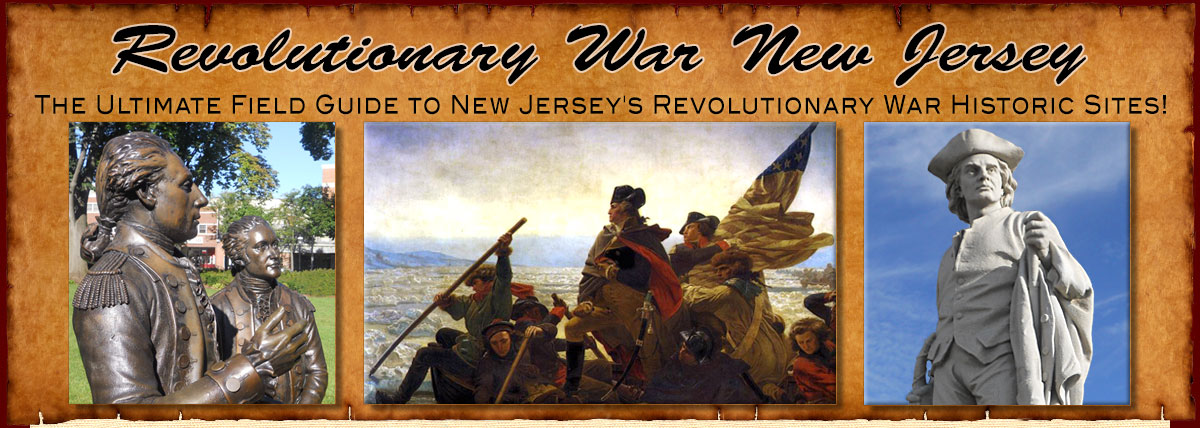

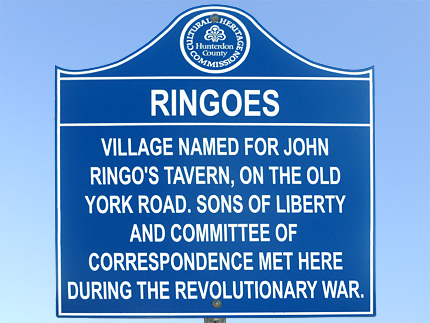
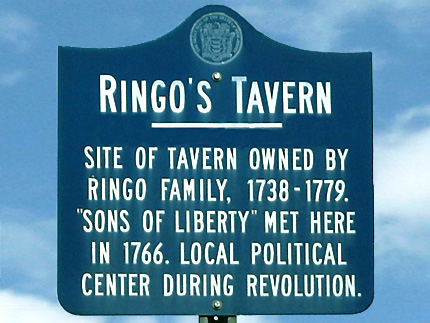
Ringoes Historic Sign
Rt. 579 near Iron Horse Drive
Map / Directions to Ringoes Historic Sign
Map / Directions to all Ringoes Revolutionary War Sites
Ringo's Tavern Site Historic Sign
Corner of Old York Rd. and Wertsville Rd.
Map / Directions to Ringo's Tavern Site
Map / Directions to all Ringoes Revolutionary War Sites
Ringo's Tavern
At the time of the Revolutionary War, taverns served multiple purposes. In addition to serving alcohol and food, they offered lodging to travelers. They also served as places for a wide range of public functions, including town meetings, legal courts, and elections. [1]
Ringo's Tavern, which was located on Old York Road, provided these functions in this area. Many important political meetings took place during the Revolutionary War era. At that time, the tavern was run by John Ringo, who had taken over the business from his father Philip.
The Stamp Act and the Sons of Liberty
In 1765, ten years before the beginning of the Revolutionary War, the British Parliament passed the Stamp Act, which imposed a tax on a wide range of paper items in the thirteen British colonies in America. The Stamp Act was very unpopular throughout the colonies. Groups calling themselves the Sons of Liberty formed to protest the Stamp Act and defend the rights of the colonists. A Sons of Liberty group formed in lower Hunterdon County and met at Ringo's Tavern in early 1766. [2]
The Stamp Act was soon repealed by the British Parliament, but the tensions which it had caused would continue to grow and would eventually lead to the beginning of the Revolutionary War in 1775.
Ringo's Tavern During the Revolutionary War
On January 18, 1775, just months before the Revolutionary War began, an important meeting of sixty citizens of Hunterdon County took place at Ringo's Tavern. They created a committee of correspondence for Hunterdon County, one of many such groups which served to facilitate communications between the different colonies. The chairman of the meeting was John Hart, who a year and a half later signed the Declaration of Independence. [3]
Throughout the war, the tavern continued to serve as a meeting place for discussing war-related matters and was attended by important figures of the era. One such meeting occurred from December 26, 1777 - January 1, 1778 and was attended by New Jersey Governor William Livingston who wrote a letter to George Washington on December 26 from Ringo's Tavern. [4]
A month later, General Lafayette came to Ringo's Tavern for a scheduled meeting with William Duir, a member of the Continental Congress. The two were to discuss a possible military incursion in Canada, but Duir never showed up to meet Lafayette at the tavern. [5] (Lafayette would return to Ringoes later that year, as described in the Landis House entry below.)
The tavern's proprietor, John Ringo, did not live to see the end of the war; he died April 12, 1779, at age 43. He is buried at the Ringo Family Burial Ground, which is located in a field behind the house at 12 Boss Road in Ringoes. [6]
Ringo's Tavern survived well in to the next century until it was destroyed in a fire on April 18, 1840. [7]

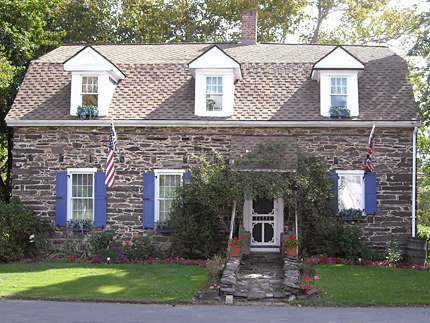
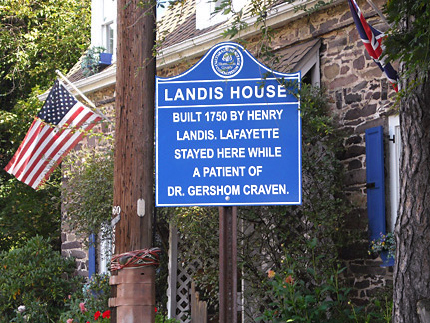
Landis House
1064 Old York Rd.
Map / Directions to Landis House
Map / Directions to all Ringoes Revolutionary War Sites
This house is a private residence.
Please respect the privacy and property of the owners.
Marquis de Lafayette
Marquis de Lafayette was a French officer who came to America to fight on the American side in the Revolutionary War. He became close to Washington, Hamilton, and other Revolutionary War figures. As described above, Lafayette came to Ringo's Tavern in early 1778 for a meeting with William Duir, who never showed up.
Later that year, around October 27, Lafayette was traveling from Philadelphia to Boston, and the early part of his route took him through Ringoes. By the time he had reached here, he was feeling sick after having traveled through a heavy rain.
Local historian Dave Harding writes that Lafayette "stopped at Ringo's Tavern where he became ill and was taken to an upper bedroom there. Dr. Gershom Craven recommended Lafayette move to [the Landis House] so he could rest in comfort and quiet. Lafayette, impatient to leave, stayed an additional evening at this home before setting off, still with a fever and facing more bad weather." [8]
Lafayette continued traveling north, and he reached Fishkill, NY, on November 2. By that time he had grown even sicker, and there was concern that he might be dying. He remained ill at Fishkill for about a month. [9] He then continued on and reached Boston, where he traveled by boat to France.
His health had been revived. He not only returned to America in 1780 to play an active part in the rest of the war, but in fact lived many decades after the war ended. He died in 1834 at age 76.
Dr. Gershom Craven, who treated Lafayette at the Landis House, was a surgeon in the Hunterdon County militia. He is buried a quarter-mile north of the house on Old York Road at the St. Andrew's Church Cemetery. (See next entry below.)

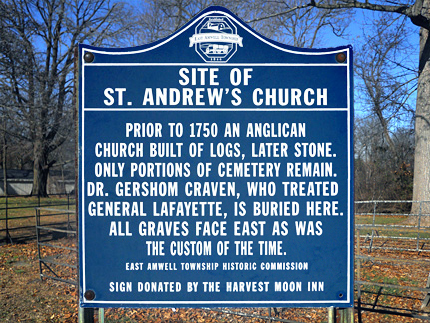
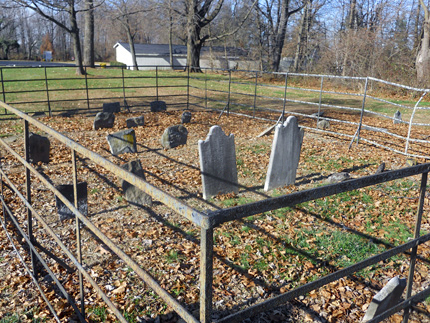
St. Andrews Church Cemetery
1064 Old York Rd., near Larison Rd.
Map / Directions to St. Andrews Church Cemetery
Map / Directions to all Ringoes Revolutionary War Sites
Dr. Gershom Craven, who treated Lafayette at the Landis House is buried here. [10]

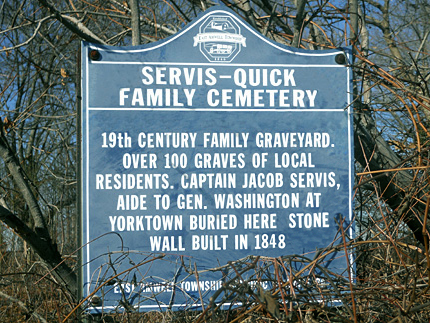
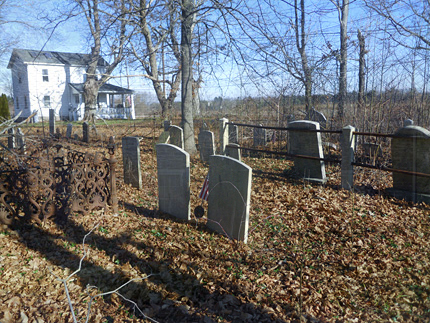
Servis-Quick Family Cemetery
113 John Ringo Rd. (Route 579)
Map / Directions to the Servis-Quick Family Cemetery
Map / Directions to all Ringoes Revolutionary War Sites

1. ^ For an interesting article about the functions of New Jersey taverns in the 1700's, see:
Margie Hofer, "A Tavern for the Town: Josiah Halstead's Tavern and Community Life in Eighteenth-Century Shrewsbury" (Freehold, NJ: Monmouth County Historical Association, 1994) Pages 1-82. ^ Minutes of a Bethlehem Town Meeting on March 11, 1766, recorded by Bethlehem Township Clerk Francis McShane, as reprinted in:
James P. Snell, History of Hunterdon and Somerset Counties, New Jersey (Philadelphia: Everts & Peck, 1881) Page 459
Available to be read at the Internet Archive here3. ^ Minutes of the Provincial Congress and the Council of Safety the State of New Jersey (Trenton: Naar, Day & Naar, 1879) Pages 49-50
Available to be read at the Internet Archive here4. ^ James P. Snell, History of Hunterdon and Somerset Counties, New Jersey (Philadelphia: Everts & Peck, 1881) Page 70
Available to be read at the Internet Archive here“To George Washington from William Livingston, 26 December 1777,” Founders Online, National Archives, last modified July 12, 2016, http://founders.archives.gov/documents/Washington/03-13-02-0005. [Original source: The Papers of George Washington, Revolutionary War Series, vol. 13, 26 December 1777 – 28 February 1778, ed. Edward G. Lengel. Charlottesville: University of Virginia Press, 2003, pp. 5–7.]
5. ^ Lafayette's meeting with Duir which never occurred is referenced in two of his letters from February 1778:
• “To George Washington from Major General Lafayette, 9 February 1778,” Founders Online, National Archives, last modified July 12, 2016, http://founders.archives.gov/documents/Washington/03-13-02-0407. [Original source: The Papers of George Washington, Revolutionary War Series, vol. 13, 26 December 1777 – 28 February 1778, ed. Edward G. Lengel. Charlottesville: University of Virginia Press, 2003, pp. 488–489.]
▸ Lafayette refers simply to "a tavern" in this letter, but the following letter makes it clear that this reference was to Ringo's Tavern.• “To George Washington from Major General Lafayette, 19 February 1778,” Founders Online, National Archives, last modified July 12, 2016, http://founders.archives.gov/documents/Washington/03-13-02-0505. [Original source: The Papers of George Washington, Revolutionary War Series, vol. 13, 26 December 1777 – 28 February 1778, ed. Edward G. Lengel. Charlottesville: University of Virginia Press, 2003, pp. 594–597.]
6. ^ Exploring Ringoes Self-Guided Tour booklet (East Amwell Historic Preservation Committee)
Available on the Township of Amwell website here
7. ^The Hunterdon Gazette [Flemington, NJ] April 22, 1840, as reprinted in:
James P. Snell, History of Hunterdon and Somerset Counties, New Jersey (Philadelphia: Everts & Peck, 1881) Page 351
Available to be read at the Internet Archive here8. ^ Exploring Ringoes Walking tour booklet (East Amwell Historic Preservation Committee)
"Here's what we've pieced together about this incident based on the Ringos' family history, Washington's correspondence and Lafayette's memoirs."
Available as a PDF on the Township of Amwell website here9. ^ Mentions of Lafayette's journey and/or his illness appear in several of Lafayette's and George Washington's letters from the time, although they do not specifically mention a stop at Ringoes or treatment by Dr. Gershom Craven.
~“To George Washington from Major General Lafayette, 24 October 1778,” Founders Online, National Archives, last modified July 12, 2016, http://founders.archives.gov/documents/Washington/03-17-02-0568. [Original source: The Papers of George Washington, Revolutionary War Series, vol. 17, 15 September–31 October 1778, ed. Philander D. Chase. Charlottesville: University of Virginia Press, 2008, pp. 556–557.]
~ “From George Washington to Vice Admiral d’Estaing, 5 November 1778,” Founders Online, National Archives, last modified July 12, 2016, http://founders.archives.gov/documents/Washington/03-18-02-0047. [Original source: The Papers of George Washington, Revolutionary War Series, vol. 18, 1 November 1778 – 14 January 1779, ed. Edward G. Lengel. Charlottesville: University of Virginia Press, 2008, pp. 48–49.]
~ “From George Washington to Major General Alexander McDougall, 8 November 1778,” Founders Online, National Archives, last modified July 12, 2016, http://founders.archives.gov/documents/Washington/03-18-02-0083. [Original source: The Papers of George Washington, Revolutionary War Series, vol. 18, 1 November 1778 – 14 January 1779, ed. Edward G. Lengel. Charlottesville: University of Virginia Press, 2008, pp. 78–79.]
~ “From George Washington to Benjamin Franklin, 28 December 1778,” Founders Online, National Archives, last modified July 12, 2016, http://founders.archives.gov/documents/Washington/03-18-02-0584. [Original source: The Papers of George Washington, Revolutionary War Series, vol. 18, 1 November 1778 – 14 January 1779, ed. Edward G. Lengel. Charlottesville: University of Virginia Press, 2008, pp. 521–522.]
10. ^ East Amwell Historic Commission sign